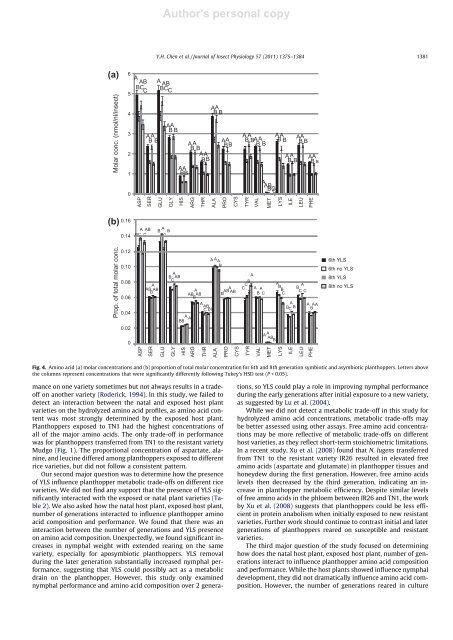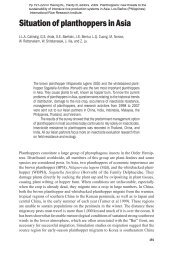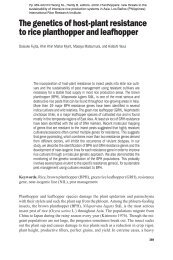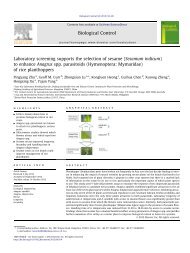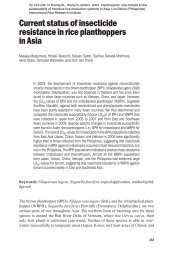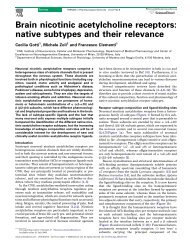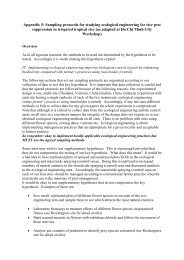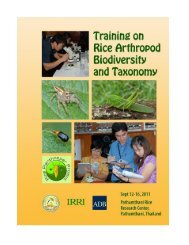Chen, Yolanda et al. 2011. Planthopper âadaptationâ - Ricehoppers
Chen, Yolanda et al. 2011. Planthopper âadaptationâ - Ricehoppers
Chen, Yolanda et al. 2011. Planthopper âadaptationâ - Ricehoppers
Create successful ePaper yourself
Turn your PDF publications into a flip-book with our unique Google optimized e-Paper software.
Author's person<strong>al</strong> copy<br />
Y.H. <strong>Chen</strong> <strong>et</strong> <strong>al</strong>. / Journ<strong>al</strong> of Insect Physiology 57 (2011) 1375–1384 1381<br />
(a)<br />
Molar conc. (nmol/nl/insect)<br />
6<br />
5<br />
4<br />
3<br />
2<br />
1<br />
A AB<br />
BC C<br />
AA<br />
BB<br />
A AB<br />
BC C<br />
AA<br />
BB<br />
AA<br />
AA BB<br />
BB<br />
AA<br />
BB<br />
AA<br />
BB<br />
A A B B AA<br />
BB<br />
A ABBCC<br />
AA<br />
AA<br />
BB<br />
B B<br />
A A<br />
BB<br />
AA<br />
BB<br />
AA<br />
B B<br />
0<br />
ASP<br />
SER<br />
GLU<br />
GLY<br />
HIS<br />
ARG<br />
THR<br />
ALA<br />
PRO<br />
CYS<br />
TYR<br />
VAL<br />
MET<br />
LYS<br />
ILE<br />
LEU<br />
PHE<br />
(b)<br />
0.16<br />
0.14<br />
0.12<br />
0.10<br />
0.08<br />
0.06<br />
0.04<br />
0.02<br />
0<br />
6th YLS<br />
6th no YLS<br />
8th YLS<br />
8th no YLS<br />
ASP<br />
SER<br />
GLU<br />
GLY<br />
HIS<br />
ARG<br />
THR<br />
ALA<br />
PRO<br />
CYS<br />
TYR<br />
VAL<br />
MET<br />
LYS<br />
ILE<br />
LEU<br />
PHE<br />
AAB<br />
BC C<br />
A B B<br />
C<br />
Prop. of tot<strong>al</strong> molar conc.<br />
A<br />
AB ABB<br />
A AB BC<br />
A A<br />
BB<br />
A<br />
AB AB<br />
B<br />
A ABBC<br />
C<br />
A A<br />
A<br />
B<br />
A<br />
AB AB<br />
B<br />
A<br />
B<br />
C<br />
C<br />
A<br />
A A BBC<br />
A<br />
B<br />
C C<br />
B C<br />
A A AA<br />
BC<br />
B B<br />
A A AB B<br />
Fig. 4. Amino acid (a) molar concentrations and (b) proportion of tot<strong>al</strong> molar concentration for 6th and 8th generation symbiotic and asymbiotic planthoppers. L<strong>et</strong>ters above<br />
the columns represent concentrations that were significantly differently following Tukey’s HSD test (P < 0.05).<br />
mance on one vari<strong>et</strong>y som<strong>et</strong>imes but not <strong>al</strong>ways results in a tradeoff<br />
on another vari<strong>et</strong>y (Roderick, 1994). In this study, we failed to<br />
d<strong>et</strong>ect an interaction b<strong>et</strong>ween the nat<strong>al</strong> and exposed host plant<br />
vari<strong>et</strong>ies on the hydrolyzed amino acid profiles, as amino acid content<br />
was most strongly d<strong>et</strong>ermined by the exposed host plant.<br />
<strong>Planthopper</strong>s exposed to TN1 had the highest concentrations of<br />
<strong>al</strong>l of the major amino acids. The only trade-off in performance<br />
was for planthoppers transferred from TN1 to the resistant vari<strong>et</strong>y<br />
Mudgo (Fig. 1). The proportion<strong>al</strong> concentration of aspartate, <strong>al</strong>anine,<br />
and leucine differed among planthoppers exposed to different<br />
rice vari<strong>et</strong>ies, but did not follow a consistent pattern.<br />
Our second major question was to d<strong>et</strong>ermine how the presence<br />
of YLS influence planthopper m<strong>et</strong>abolic trade-offs on different rice<br />
vari<strong>et</strong>ies. We did not find any support that the presence of YLS significantly<br />
interacted with the exposed or nat<strong>al</strong> plant vari<strong>et</strong>ies (Table<br />
2). We <strong>al</strong>so asked how the nat<strong>al</strong> host plant, exposed host plant,<br />
number of generations interacted to influence planthopper amino<br />
acid composition and performance. We found that there was an<br />
interaction b<strong>et</strong>ween the number of generations and YLS presence<br />
on amino acid composition. Unexpectedly, we found significant increases<br />
in nymph<strong>al</strong> weight with extended rearing on the same<br />
vari<strong>et</strong>y, especi<strong>al</strong>ly for aposymbiotic planthoppers. YLS remov<strong>al</strong><br />
during the later generation substanti<strong>al</strong>ly increased nymph<strong>al</strong> performance,<br />
suggesting that YLS could possibly act as a m<strong>et</strong>abolic<br />
drain on the planthopper. However, this study only examined<br />
nymph<strong>al</strong> performance and amino acid composition over 2 generations,<br />
so YLS could play a role in improving nymph<strong>al</strong> performance<br />
during the early generations after initi<strong>al</strong> exposure to a new vari<strong>et</strong>y,<br />
as suggested by Lu <strong>et</strong> <strong>al</strong>. (2004).<br />
While we did not d<strong>et</strong>ect a m<strong>et</strong>abolic trade-off in this study for<br />
hydrolyzed amino acid concentrations, m<strong>et</strong>abolic trade-offs may<br />
be b<strong>et</strong>ter assessed using other assays. Free amino acid concentrations<br />
may be more reflective of m<strong>et</strong>abolic trade-offs on different<br />
host vari<strong>et</strong>ies, as they reflect short-term stoichiom<strong>et</strong>ric limitations.<br />
In a recent study, Xu <strong>et</strong> <strong>al</strong>. (2008) found that N. lugens transferred<br />
from TN1 to the resistant vari<strong>et</strong>y IR26 resulted in elevated free<br />
amino acids (aspartate and glutamate) in planthopper tissues and<br />
honeydew during the first generation. However, free amino acids<br />
levels then decreased by the third generation, indicating an increase<br />
in planthopper m<strong>et</strong>abolic efficiency. Despite similar levels<br />
of free amino acids in the phloem b<strong>et</strong>ween IR26 and TN1, the work<br />
by Xu <strong>et</strong> <strong>al</strong>. (2008) suggests that planthoppers could be less efficient<br />
in protein anabolism when initi<strong>al</strong>ly exposed to new resistant<br />
vari<strong>et</strong>ies. Further work should continue to contrast initi<strong>al</strong> and later<br />
generations of planthoppers reared on susceptible and resistant<br />
vari<strong>et</strong>ies.<br />
The third major question of the study focused on d<strong>et</strong>ermining<br />
how does the nat<strong>al</strong> host plant, exposed host plant, number of generations<br />
interact to influence planthopper amino acid composition<br />
and performance. While the host plants showed influence nymph<strong>al</strong><br />
development, they did not dramatic<strong>al</strong>ly influence amino acid composition.<br />
However, the number of generations reared in culture


